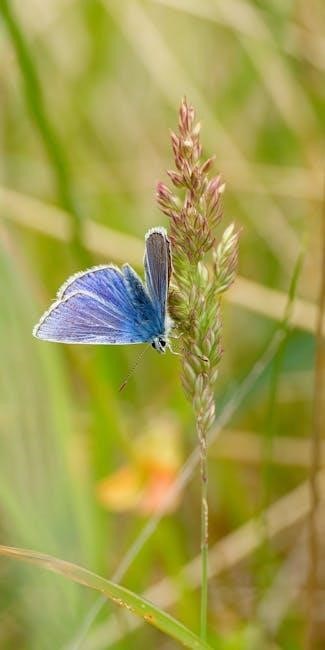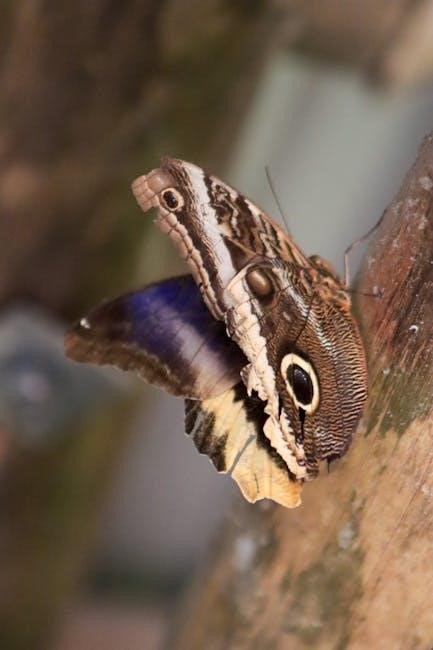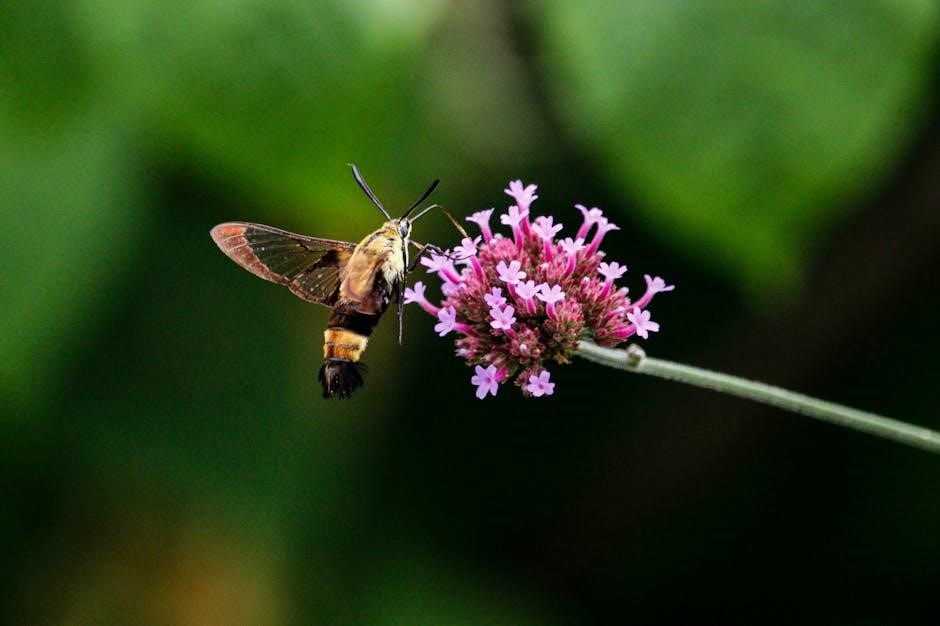The peppered moth simulation is an educational tool demonstrating natural selection. It allows students to explore how environmental changes, like the Industrial Revolution, impact moth populations and adaptation.
1.1 Overview of the Peppered Moth Simulation
The peppered moth simulation is an interactive educational activity that models natural selection. Students act as predators, selecting moths based on their coloration, which mimics real-world evolutionary processes. The simulation uses materials like colored paper circles to represent light and dark moths, placed on tree branches. Participants observe how environmental factors, such as pollution, influence moth survival and adaptation. This hands-on approach helps students grasp the principles of natural selection and its role in population changes over time.
1.2 Importance of the Peppered Moth in Evolutionary Studies
The peppered moth is a cornerstone of evolutionary studies, exemplifying natural selection in action. Its color variation, influenced by the Industrial Revolution, demonstrates how environmental changes drive adaptation. This case study is vital for understanding how species evolve over time, making it a key teaching tool in biology. The moth’s story bridges theory and observation, providing tangible evidence of evolution’s mechanisms and their impact on biodiversity.
Background of the Peppered Moth
The peppered moth, native to England, originally had a light-colored, speckled appearance, blending with lichen-covered trees. Its history intertwines with the Industrial Revolution, sparking evolutionary changes.
2.1 History of the Peppered Moth and the Industrial Revolution
The peppered moth underwent significant evolutionary changes during the Industrial Revolution. Prior to this period, the moth population was predominantly light-colored, allowing them to blend with lichen-covered tree bark. However, as factories emitted pollutants, tree trunks darkened due to soot, altering the moths’ environment. This shift favored the survival of dark-colored moths, which were less visible to predators on dark backgrounds. This dramatic change illustrates natural selection driven by industrialization.
2.2 The Science Behind Moth Color Variation
The peppered moth’s color variation is genetically determined, with light and dark forms influenced by environmental pressures. The light-colored moths blended well with lichen-covered trees, while dark-colored moths thrived in polluted, darkened environments. This variation allowed natural selection to favor the most adapted phenotype, demonstrating how genetic diversity interacts with environmental changes to drive evolutionary shifts. The moths’ ability to camouflage themselves reduced predation, highlighting the role of adaptation in survival.

The Simulation Setup
The simulation setup involves materials like colored paper circles, representing moths, and a dark or light background to mimic environmental conditions. Students act as predators, selecting moths based on visibility, demonstrating natural selection principles effectively in an engaging, hands-on manner to explore evolutionary changes in moth populations over generations.
3.1 Materials Needed for the Simulation
The simulation requires materials such as colored paper circles to represent light and dark moths, scissors for cutting, and glue for attaching them to different backgrounds. A white or dark surface mimics tree bark, allowing observation of moth visibility. Data sheets and an answer key in PDF format are essential for recording and assessing student responses, ensuring accurate and efficient evaluation of the simulation’s outcomes.
3.2 Step-by-Step Guide to Conducting the Simulation
Begin by preparing materials, including colored circles for moths and varied backgrounds. Students assume the role of predators, selecting moths based on visibility. Record the number of light and dark moths “eaten” in each trial. Repeat the process for multiple generations, simulating environmental changes like pollution. Afterward, analyze data to observe shifts in moth populations, reflecting natural selection. Ensure accurate documentation using the provided answer key for evaluation and discussion of results.
3.3 Roles in the Simulation (e.g., Birds, Moths)
In the simulation, students typically assume the role of birds, acting as predators selecting moths based on their visibility. Moths are represented by colored circles or paper cutouts, with variations in color mimicking light and dark morphs. Birds “prey” on moths, while other roles may include data recorders or environment setters. This setup mimics natural selection, allowing participants to observe how environmental pressures influence survival and adaptation. The answer key helps assess understanding of these roles and their ecological implications.
The Answer Key
The answer key provides correct responses to simulation-related questions, ensuring accurate assessment of student understanding of natural selection and moth variation concepts.
4.1 Explanation of the Answer Key Structure
The answer key is organized to align with the simulation’s learning objectives, providing correct responses to questions about moth variation, natural selection, and environmental impacts. It includes answers to multiple-choice and open-ended questions, ensuring clarity for both students and educators. The structure mirrors the simulation’s flow, addressing key concepts like camouflage, predation, and population changes. This format helps in assessing student understanding and facilitating deeper discussions about evolutionary principles.
4.2 Key Questions and Answers from the Simulation
Q: How does moth coloration affect survival? A: Light moths are less visible on light trees, while dark moths blend better on dark trees, increasing survival.
Q: What role do birds play? A: Birds act as predators, selecting moths based on visibility, simulating natural selection pressures.
Q: How did the Industrial Revolution impact moths? A: Pollution darkened trees, favoring dark moths, demonstrating rapid evolutionary change.
Q: What is the main outcome of the simulation? A: It shows how environmental changes drive adaptation through natural selection.

Results and Analysis
The simulation reveals shifts in moth population dynamics, with dark moths thriving in polluted environments. Data analysis highlights natural selection’s role in driving these evolutionary changes.
5.1 Expected Outcomes of the Simulation
The simulation demonstrates how environmental changes influence moth populations. In polluted areas, dark-colored moths dominate, while light-colored moths thrive in cleaner environments. This mirrors real-world evolutionary shifts observed during the Industrial Revolution, showcasing natural selection’s impact on adaptation and survival rates. Students can expect clear data trends aligning with these outcomes, reinforcing the concept of environmental pressures driving evolutionary changes.
5.2 Interpreting Data from the Simulation
Interpreting simulation data involves analyzing survival rates of light and dark moths across generations. In polluted environments, dark moths typically dominate, while light moths prevail in cleaner conditions. This reflects natural selection, where environmental pressures favor certain traits. By comparing initial and final populations, students can visualize evolutionary changes. The data highlights how predation and pollution drive adaptation, offering insights into real-world ecological dynamics and reinforcing evolutionary principles through hands-on observation and analysis.
Connecting the Simulation to Natural Selection
The simulation mirrors natural selection by showing how environmental pressures, like pollution, favor certain moth traits, leading to evolutionary changes in populations over generations.
6.1 How the Simulation Demonstrates Natural Selection
The simulation illustrates natural selection by allowing participants to act as predators, selecting moths based on their coloration. Light-colored moths are more visible on dark backgrounds, while dark-colored moths blend in better. This mimics how environmental changes, like pollution, favor certain traits, leading to evolutionary shifts. Over generations, the moth population’s color distribution changes, reflecting adaptation to their environment. This hands-on approach helps students grasp how natural selection drives species adaptation in response to environmental pressures.
6.2 Real-World Implications of the Simulation
The simulation highlights how environmental changes, like pollution, drive evolutionary adaptation. The shift from light to dark moths during the Industrial Revolution exemplifies this. Such changes reveal how species adapt to human-induced environmental shifts, impacting biodiversity. Understanding these dynamics helps address real-world ecological challenges, such as conservation and managing human effects on ecosystems, emphasizing the importance of environmental stewardship and sustainable practices to mitigate evolutionary disruptions caused by human activities.

Educational Impact
The peppered moth simulation effectively teaches natural selection and adaptation, engaging students through interactive learning. It simplifies complex evolutionary concepts, fostering critical thinking and scientific inquiry skills among learners.
7.1 Learning Outcomes for Students
Students gain a clear understanding of natural selection and adaptation through the peppered moth simulation. They learn to analyze data, observe evolutionary changes, and connect theoretical concepts to real-world scenarios. The simulation enhances critical thinking, scientific inquiry, and problem-solving skills. Students also develop an appreciation for environmental impacts on species and the role of predation in driving evolutionary processes. These outcomes align with curriculum standards, making the simulation an effective educational tool.
7.2 Curriculum Connections
The peppered moth simulation aligns with biology, ecology, and environmental science curricula, addressing natural selection, adaptation, and evolutionary concepts. It connects to standards requiring hands-on, inquiry-based learning, fostering critical thinking and data analysis skills. The simulation also links to discussions on ecosystems, biodiversity, and human-induced environmental changes, making it a versatile tool for cross-curricular integration and meeting educational objectives in STEM subjects.

Variations and Extensions
The simulation can be enhanced by incorporating real-time data visualization or interactive elements. Advanced variations may include exploring genetic factors or adding environmental variables like pollution levels.
8.1 Alternative Methods for Conducting the Simulation
Alternative methods include using digital tools like simulations software or interactive games. These methods allow for real-time data visualization and can be more engaging. Additionally, incorporating virtual labs or online platforms provides flexibility for remote learning. Some educators use 3D models or augmented reality to enhance the experience. These approaches maintain the core concept while offering varied learning experiences for students. They also provide opportunities for data analysis and discussion, aligning with curriculum standards and promoting deeper understanding of natural selection principles. Exploring different technologies can cater to diverse learning styles and preferences, ensuring all students can participate effectively. Furthermore, digital alternatives often include pre-programmed answer keys and automated assessments, streamlining the grading process for instructors. This adaptability makes the simulation accessible and effective in various educational settings, whether traditional classrooms or online environments. By leveraging technology, the simulation remains relevant and engaging, fostering a comprehensive learning experience. Educators can choose the method that best suits their resources and student needs, ensuring the simulation’s objectives are met regardless of the approach. Overall, alternative methods enhance the simulation’s flexibility and educational impact, making it a valuable tool for teaching evolutionary concepts. These variations encourage creative problem-solving and critical thinking, essential skills for students in science education. The ability to adapt the simulation to different formats ensures its longevity and effectiveness in educational curricula. As technology advances, new methods will continue to emerge, offering even more innovative ways to conduct the simulation and teach natural selection. This dynamic approach keeps the content fresh and engaging for new generations of learners, ensuring the peppered moth simulation remains a cornerstone of evolutionary education. The integration of alternative methods also supports interdisciplinary learning, connecting biology with technology and data analysis. This holistic approach provides students with a well-rounded understanding of scientific principles and their applications. In conclusion, alternative methods for conducting the simulation offer numerous benefits, from enhanced engagement to streamlined processes, making it a versatile and effective educational resource. Educators can confidently adopt these methods to deliver a high-quality learning experience that aligns with modern educational standards. The flexibility and adaptability of the simulation ensure its continued relevance in teaching the fundamental concepts of natural selection; By embracing alternative methods, educators can cater to the diverse needs of their students, ensuring that everyone has the opportunity to grasp the essential principles of evolutionary biology through an engaging and interactive experience. The evolution of simulation methods parallels advancements in technology, providing educators with a dynamic toolkit to inspire and educate future scientists. As educational technology continues to evolve, the peppered moth simulation will remain a vital and adaptable resource for teaching natural selection, ensuring its place in science education for years to come. The availability of alternative methods also supports the inclusion of students with varying learning abilities, creating a more inclusive and equitable educational environment. This inclusivity is crucial for fostering a love of learning and promoting academic success for all students. By offering multiple approaches to conducting the simulation, educators can address the unique needs of their students, ensuring that everyone can participate fully and benefit from the experience. The adaptability of the simulation makes it a powerful tool for educators, enabling them to create a personalized and effective learning experience. As educational strategies continue to develop, the peppered moth simulation will remain a cornerstone of science education, adapting to new methods and technologies to provide an optimal learning experience. The use of alternative methods not only enhances the simulation’s effectiveness but also prepares students for the demands of a rapidly changing world, where adaptability and problem-solving are essential skills. By engaging with the simulation through various methods, students develop a deeper understanding of evolutionary principles and their real-world applications. This comprehensive approach to learning ensures that students are well-prepared to tackle complex scientific concepts and think critically about the world around them. The integration of alternative methods into the simulation also encourages collaboration and teamwork, as students work together to explore different approaches and share their findings. This collaborative environment fosters a sense of community and mutual support, enhancing the overall learning experience. Educators can encourage students to reflect on their experiences with different simulation methods, promoting metacognition and self-directed learning. This reflective practice helps students identify their strengths and areas for improvement, guiding their future learning endeavors. The availability of alternative methods also allows educators to differentiate instruction, catering to the varied interests and capabilities of their students. This differentiated approach ensures that each student can engage with the material in a way that is meaningful and challenging for them. By providing multiple avenues for exploration, the simulation becomes a dynamic and responsive tool that meets the diverse needs of learners. As a result, the peppered moth simulation remains a vital and effective resource for teaching natural selection, offering a rich and varied learning experience that prepares students for success in science and beyond. The continuous development of alternative methods ensures that the simulation stays relevant and engaging, keeping pace with the ever-evolving landscape of educational technology. This commitment to innovation guarantees that the simulation will continue to inspire and educate students, providing them with the knowledge and skills necessary to excel in their academic and professional pursuits. Ultimately, the adaptability of the peppered moth simulation is a testament to the power of educational innovation, demonstrating how a single concept can be transformed into a multifaceted learning experience through creativity and technology. As educators embrace these alternative methods, they empower their students to explore, discover, and learn in ways that are both effective and enjoyable. The future of science education is bright, and the peppered moth simulation stands as a shining example of how innovative approaches can enhance the learning experience, ensuring that students are equipped with the tools they need to succeed in an increasingly complex and interconnected world.
8.2 Advanced Concepts for Further Exploration
Advanced concepts include exploring genetic drift, epistasis, and pleiotropy in moth populations. Students can investigate how industrial melanism interacts with climate change or urbanization. Additionally, integrating real-world data on carbon emissions and tree bark darkness can deepen understanding; Exploring molecular mechanisms behind color variation, such as the role of the Biston betularia gene, offers insights into evolutionary genetics. These extensions encourage critical thinking and interdisciplinary connections, preparing students for advanced scientific inquiry;
